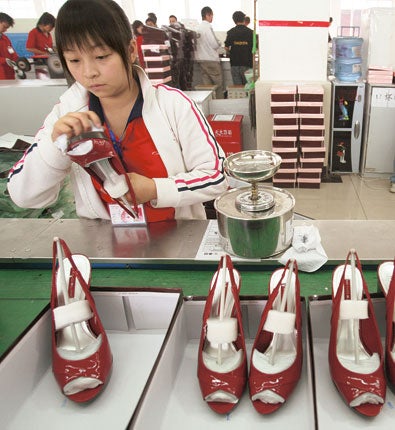Choose shoes as good as Choo's, says China's 'Choo'
Designer wants Chinese factories to stamp out copies and make original footwear

Nearly all the shoes in the world are made in China. But one man is making it his mission to convince Chinese factories to make their footwear more stylish and original rather than simply knocking off ideas from Western designers.
David Hsieh knows a thing or two about shoes. He has worked at Adidas, Clarks and Benetton. And he once shared a basement in the East End of London with Jimmy Choo, before anyone, let alone the world's best-shod celebrities, had heard of Choo.
Hsieh's message is finally being taken in by Chinese shoe companies who realise that coming up with original designs is the only way to show a clean set of heels to the competition and make your shoes stand out from the billions made here every year.
"I hope that one day we'll have China brands, not just copycat brands. In apparel you see this happening, but it's early days for footwear. Shoes are all made in China but there are no good China brands – it's a pity," he said. "But slowly they are seeing the added value creativity brings." In a luxury apartment lined with all kinds of footwear, including some very fetching pink loafers and smooth-looking sport-casual shoes, Hsieh explained how he is hoping to change the way people think about "made in China".
China exports 10 billion pairs of shoes every year and a quarter come from Dongguan, so it was natural his crusade to bring a bit of flair to shoe manufacturing in the region should begin in this teeming industrial zone in Guangdong.
The drive to get to Hsieh's studio in Dongguan, home to some of the world's biggest factories, is a trip through a giant industrial estate, endless rows of factories, dormitories and suppliers, with new motorways whisking company execs from factory to factory.
A number of plants have closed because of the economic downturn, which has caused China's export market to dry up. Manufacturing is contracting, but an enormous state injection of cash into the economy seems to be bearing fruit and the World Bank reckons China should start pulling out of the recession later this year.
It's hard to find any anecdotal evidence of a downturn in southern China. All is energetic, busy, and all factory owners are keen to find a way out of the downturn rather than focusing on the misery.
Hsieh clears space among the designs on the table as he recalls how his father worked for a shoe company and after he finished his military service in Taiwan, he told his dad he wanted to stay in footwear,and become a designer. He won a scholarship to the famous London fashion academy, Cordwainers College.
He worked at Adidas in China during his time at college, and found sports shoes an interesting distraction from the high heels he had been designing at college, a skill he honed working with the Malaysian-Chinese Jimmy Choo in that basement in Hackney.
Later he worked in Herzogenaurach in Bavaria, Adidas's home town, then went on to design shoes for Benetton, attracted by the Italian lifestyle. He was involved in setting up a brand with a former Clarks director, before he joined the company at its British headquarters for a year and a half.
However, Hsieh wanted to build his own brands and, proud of his roots, he wanted to help China. So he moved and set about his new mission: urging Chinese shoe companies to innovate.
"Most companies here just get the pattern-cutter to come up with the design," he said, "but for me that's a mistake. The design philosophy is not mature. Many brands are happy to copy foreign shoes, or modify them, then put them out at a cheap price." He has been dealing with around 20 companies, trying to convince them to compete on design, not just price, and so far four companies have taken his ideas on board.
"Most companies think the way forward is through innovation, but they are a bit afraid to change. There is still a product-driven mentality, and I have to tell them they can get a better margin with original products," said Hsieh.
"Increasingly they understand that the factories that will survive this difficult time will be the ones who have a successful brand."
He has spoken to students at the design faculty at the university in Guangzhou, trying to inculcate a sense of its importance.
"This is all about the added value of creativity. And I'm proud to have my Chinese name on my name card."
Subscribe to Independent Premium to bookmark this article
Want to bookmark your favourite articles and stories to read or reference later? Start your Independent Premium subscription today.

Join our commenting forum
Join thought-provoking conversations, follow other Independent readers and see their replies